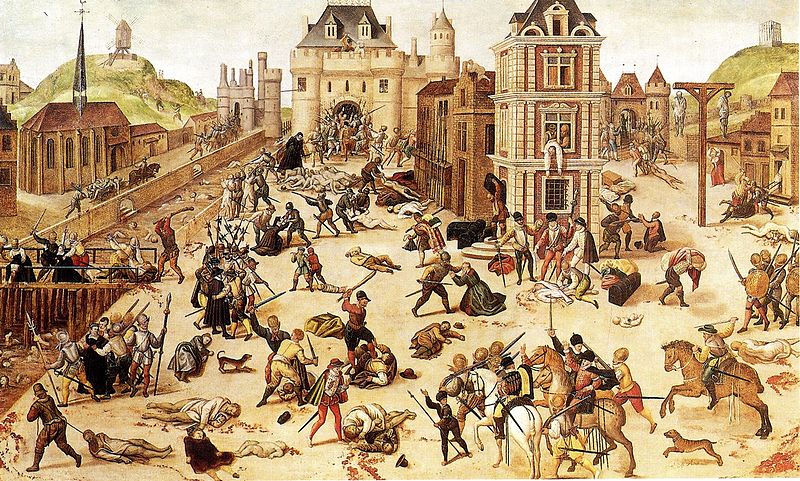THE ST. BARTHOLOMEW'S DAY MASSACRE
POPE GREGORY XIII CELEBRATES
THE MASS MURDER OF FRENCH PROTESTANTS

In 1572, Catherine de Medici and her son, King Charles IX of France, in league with Pope Gregory XIII, carried out a plan to lure thousands of Protestants to Paris, ostensibly to attend a royal wedding between a Catholic princess and a Protestant nobleman. The wedding was presented as an opportunity to seal the Peace of St. Germain between French Protestants and Catholics, which had ended the Third War of Religion in France. Instead, it amounted to a successful plot to destroy Protestantism in France by murdering a significant percentage of leading Protestant nobles, and a large number of ordinary Protestants as well.
Background
Although the Peace of St. Germain (signed in August 1570) formally brought to an end three-years of warfare between Catholics and Protestants in France, hostility between the two branches of Christianity continued unabated. By 1570 three wars over religion already had been fought in France, leaving lasting enmity in their wake. For their part, French Catholics were violently opposed to the Peace of St. Germain and many refused to accept it despite appeals from the royal family. In 1571 and into 1572, the French Queen Mother, Catherine de Medici, and her son, King Charles IX, appeared eager to reconcile the two sides by marrying her daughter, Marguerite de Valois, to the Protestant prince, Henry of Navarre. In reality, however, the French monarchy conspired with the Pope in Rome to use the marriage as an opportunity to lure the Protestant nobility to Paris and murder them, in order to stamp out armed Protestantism in France. The royal marriage was arranged to take place on August 15, 1572.
The Massacre
The marriage was concluded successfully, but tensions within fervently Catholic Paris were raised to a fever-pitch by the presence of a large number of Protestants (called Huguenots in France) in the city for the wedding ceremony. For several days after the wedding a group of Huguenots led by Admiral Gaspard de Coligny remained in Paris to discuss complaints they had about the Peace of St. Germain. Then, on August 22, an assassination attempt was made on Coligny's life. Charles IX initially called for the arrest of the assailant, but he soon performed an abrupt about-face and implemented the plan to eliminate Huguenots within the city. Orders were given to arm the populace of Paris and lock the city gates. The royal Swiss Guard was instructed to expel Protestant nobles from the royal palace and to kill the leaders of the Protestant delegation. Coligny was dragged from his sickbed and thrown out of a palace window. Meanwhile, the Protestant nobles expelled from the palace were slaughtered outside. The local populace, now armed, exploded in a wave of anti-Huguenot violence. For three days Protestants were hunted throughout the city, with almost 4,000 people being murdered in the streets, including women and children. As news of events in Paris spread, the massacre of Huguenots by Catholics continued in a number of other French cities, resulting in the killing of tens of thousands of people throughout the land.
Papal Reaction
THE MASS MURDER RECEIVES OFFICIAL CHURCH BLESSING
Upon hearing of the bloodshed in Paris, Pope Gregory XIII celebrated by declaring a jubilee day of public thanksgiving. Guns were fired in salute and the Pope ordered the striking of a commemorative medallion. Subsequently, Gregory XIII also commissioned a mural by Giorgio Vasari to hang in the Vatican depicting the wondrous St. Bartholomew's Day Massacre.
Various scholars have depicted the Pope's reaction as follows:
"The news of the bloody deed was received with unbounded joy by the pope at the Vatican. The Cardinal of Lorraine presented the messenger who brought the news to Rome with a thousand pieces of gold and exclaimed that the King's heart had been filled with a sudden inspiration from God when he ordered the massacre."
"The pope and his Cardinals proceeded at once to the High Altar, after the dispatches from Paris had been read in Conclave, to offer thanks for 'the great blessing which Heaven vouchsafed to the Roman See and to all Christendom. Salvoes of artillery thundered at nightfall from the ramparts of St. Angelo; the streets were illuminated; and no victory ever achieved by the arms of the Pontificate elicited more tokens of festivity. The pope also, as if resolved that an indestructible evidence of the perversion of moral feeling which Fanaticism necessarily generates should be transmitted to posterity, gave orders for the execution of a commemorative Medal."
"Through the streets of the Eternal City swept, in the full blaze of Pontifical pomp, Gregory and his attendant train of cardinals, bishops and monks, to the Church of St. Mark, there to offer up prayers and thanksgivings to the God of heaven for His great blessing to the See of Rome and the Roman Catholic Church. Over the portico of the church was hung a cloth of purple, on which was a Latin inscription most elegantly embroidered in letters of gold, in which it was distinctly stated that the massacre had occurred after 'counsels had been given.' On the following day the Pontiff went in procession to the Church of Minerva, where, after mass, a jubilee was published to all Christendom, 'that they might thank God for the slaughter of the enemies of the Church, lately executed in France.' A third time did the pope go in procession, with his cardinals and all the foreign ambassadors then resident at his court, and after mass in the Church of St. Louis, he accepted homage from the Cardinal of Lorraine, and thanks in the name of the King of France, for the counsel and help he had given him by his prayers, of which he had found the most wonderful effects."[*]
The St, Bartholomew's Day Massacre
A History of the St. Bartholomew's Day Massacre